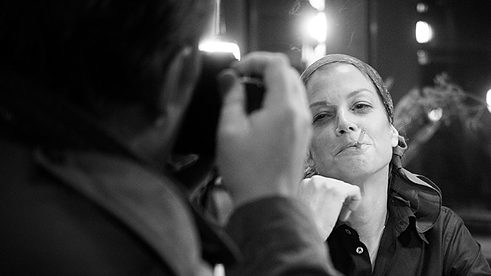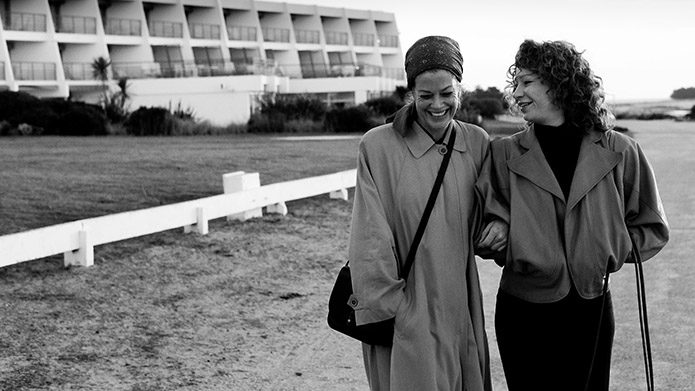Sydney Film Festival 2018
3 Days in Quiberon: A star unmasked

A picture might be worth a thousand words, but a thousand photographs still can’t tell a person’s entire story. For Romy Schneider, a lifetime of film roles and paparazzi shots certainly couldn’t capture the Austrian-born star’s complexity, or convey the complicated woman behind the public facade. But '3 Days in Quiberon' convincingly takes the viewer beyond the surface of Schneider’s stardom and her final attempt to control it.
To set the record straight — to tell her own tale her own way — Romy Schneider agreed to an extensive interview with German journalists from Stern magazine in 1981. In the French seaside town of Quiberon, they met, chatted and went well beyond the usual, formal, professional back-and-forth. It would be the last interview that Schneider would ever give, with the actress passing away in May of 1982.
BEHIND THE IMAGE, BEHIND THE INTERVIEW
If Schneider’s three days in Quiberon represented her attempt to flesh out a figure seen so often on the screen and the page, pairing her own words with her own image, then Emily Atef’s 3 Days in Quiberon endeavours to add further weight, importance and context to an interview that has influenced Schneider’s reputation and legacy in the decades since the star’s death. It’s the filmic equivalent of the events it depicts, and it offers a case of art imitating life in a particularly specific way. Just as Schneider herself was pivotal in the real-life discussion — not only in agreeing to it, but in shaping it with her candor — Marie Bäumer’s portrayal of the Sissi, The Trial, What’s New Pussycat? and A Simple Story actress is instrumental in this involving biopic.“I am an unhappy 42-year-old woman and my name is Romy Schneider,” is one of the famous quotes from the film’s central interview, and a statement Bäumer’s Schneider makes clear in every moment of 3 Days in Quiberon. Although the movie is bookended by scenes on a Brittany beach, there’s always sadness lurking in the star’s eyes, even when she’s enjoying a rare moment completely away from the spotlight. Her troubles start coming up in conversation once her lifelong friend Hilde (Birgit Minichmayr) arrives, their dinner-side chats touching upon sobriety, finances and Schneider’s 14-year-old son David (Kalle Schmitz) among other topics. After Stern’s journalist Michael Jürgs (Robert Gwisdek) and photographer Robert Lebeck (Charly Hübner) join the group, every word spoken is loaded with revelations — most offered during hotel room meetings, and ultimately destined for the page; some shared over drinks in bars, yet still leaving an imprint on the printed piece.
A PERSUASIVE AND PERCEPTIVE PERFORMANCE
Talk might be plentiful, and details about Schneider’s life free-flowing as a result; however Atef’s feature comes to life not in its discussion but in its quiet details. Like My Week with Marilyn, a comparable glimpse behind the shine of stardom that 3 Days in Quiberon’s name instantly brings to mind, this is a film that directs the audience’s gaze towards the way things are said, as well as the things that aren’t said and the weight silence can have in such close, intimate confines. Accordingly and unsurprisingly, it’s a movie guided by its key figure, with Bäumer turning her uncanny resemblance to Schneider into much more than a mere impersonation. Though ably supported by the feature’s three other main players — with Holy Motors’ Denis Lavant and Phantom Thread’s Vicky Krieps also appearing in minor roles — Bäumer unearths the many sides of a woman sorrowfully accustomed to hiding her true self. Thrusting Bäumer to the fore and letting her embody Schneider’s various facets so persuasively and perceptively might be Atef’s biggest directorial coup.
| © Sydney Film Festival
Indeed, 3 Days in Quiberon’s portrayal conveys Schneider’s flirty charm, nervous uncertainty and long-held pain, usually all at once. The beauty in Bäumer’s performance is that it doesn’t dole out time for competing parts of Schneider’s personality, but presents the actress as the constant sum of intertwined components and emotions that often drive the same actions in different ways. As such, the film insightfully dismantles the standard star persona, while also peering beyond the stereotypical behind-the-scenes glimpse that can paint the famous as the combination of a mere handful of deeper traits. Anything else wouldn’t do Schneider justice, though there’s no simplifying her struggles, issues, choices and worries in a few words, facial expressions or easy explanations, and nor does Bäumer or Atef try to.
Thrusting Bäumer to the fore and letting her embody Schneider’s various facets so persuasively and perceptively might be Atef’s biggest directorial coup.
| © Sydney Film Festival
Indeed, 3 Days in Quiberon’s portrayal conveys Schneider’s flirty charm, nervous uncertainty and long-held pain, usually all at once. The beauty in Bäumer’s performance is that it doesn’t dole out time for competing parts of Schneider’s personality, but presents the actress as the constant sum of intertwined components and emotions that often drive the same actions in different ways. As such, the film insightfully dismantles the standard star persona, while also peering beyond the stereotypical behind-the-scenes glimpse that can paint the famous as the combination of a mere handful of deeper traits. Anything else wouldn’t do Schneider justice, though there’s no simplifying her struggles, issues, choices and worries in a few words, facial expressions or easy explanations, and nor does Bäumer or Atef try to.